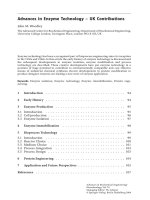advances in brain imaging
Bạn đang xem bản rút gọn của tài liệu. Xem và tải ngay bản đầy đủ của tài liệu tại đây (5.45 MB, 204 trang )
Advances in
Brain Imaging
Review of Psychiatry Series
John M. Oldham, M.D.
Michelle B. Riba, M.D., M.S.
Series Editors
No. 4
Washington, DC
London, England
Advances in
Brain Imaging
EDITED BY
John M. Morihisa, M.D.
Note: The authors have worked to ensure that all information in this book
concerning drug dosages, schedules, and routes of administration is accurate as
of the time of publication and consistent with standards set by the U.S. Food and
Drug Administration and the general medical community. As medical research
and practice advance, however, therapeutic standards may change. For this
reason and because human and mechanical errors sometimes occur, we
recommend that readers follow the advice of a physician who is directly involved
in their care or the care of a member of their family. A product’s current package
insert should be consulted for full prescribing and safety information.
Books published by American Psychiatric Publishing, Inc., represent the views
and opinions of the individual authors and do not necessarily represent the
policies and opinions of APPI or the American Psychiatric Association.
Copyright © 2001 American Psychiatric Publishing, Inc.
04 03 02 01 4 3 2 1
ALL RIGHTS RESERVED
Manufactured in the United States of America on acid-free paper
First Edition
American Psychiatric Publishing, Inc.
1400 K Street, NW
Washington, DC 20005
www.appi.org
The correct citation for this book is
Morihisa JM (editor): Advances in Brain Imaging (Review of Psychiatry Series,
Volume 20, Number 4; Oldham JM and Riba MB, series editors). Washington,
DC, American Psychiatric Publishing, 2001
Library of Congress Cataloging-in-Publication Data
Advances in brain imaging / edited by John M. Morihisa.
p. ; cm. — (Review of psychiatry ; v. 20, no. 4)
Includes bibliographical references and index.
ISBN 1-58562-028-9 (alk. paper)
1. Brain—Imaging. 2. Mental illness—Diagnosis. I. Morihisa, John M., 1951–
II. Review of psychiatry series ; v. 20, 4.
[DNLM: 1. Mental Disorders—diagnosis. 2. Brain—physiopathology. 3. Brain
Mapping—methods. 4. Diagnostic Imaging—methods. 5. Psychiatry—methods.
WM 141
A2445 2001]
RC473.B7 A35 2001
616.89′075—dc21
2001016043
British Library Cataloguing in Publication Data
A CIP record is available from the British Library.
Cover photograph: Copyright © 2001 Custom Medical Stock Photo, Inc.
Contents
Contributors ix
Introduction to the Review of Psychiatry Series xi
John M. Oldham, M.D., and
Michelle B. Riba, M.D., M.S., Series Editors
Foreword xv
John M. Morihisa, M.D.
Chapter 1
Functional Brain Imaging in
Psychiatry: The Next Wave 1
Joseph H. Callicott, M.D.
Functional Magnetic Resonance
Imaging (fMRI) in Psychiatry 3
A Dynamic Approach to Brain
Mapping in Psychiatry 8
Magnetic Resonance and Genetic Susceptibility 15
Conclusions 17
References 18
Chapter 2
Cognitive Neuroscience: The New
Neuroscience of the Mind and
Its Implications for Psychiatry 25
Cameron S. Carter, M.D.
Executive Functions and the Brain 27
ACC and Performance Monitoring 29
DLPFC and Top-Down Control 32
Impaired Executive Functions in
Schizophrenia: Role of DLPFC and ACC 36
DLPFC and Impaired Executive
Functions in Schizophrenia 38
ACC and Impaired Performance
Monitoring in Schizophrenia 41
Overcontrol and Dysfunctional Performance
Monitoring in OCD: Role of the ACC 43
Conclusions 45
References 47
Chapter 3
Functional Magnetic Resonance Imaging in
Children and Adolescents: Implications for
Research on Emotion 53
Daniel S. Pine, M.D.
Developmental Psychopathology Perspectives
Applied to Mood and Anxiety Disorders 55
Data Implicating Neural Circuits in
Pediatric Mood and Anxiety Disorders 59
Using fMRI to Probe Developmental
Dysfunction in Neural Circuits 66
Conclusions 74
References 75
Chapter 4
Brain Structure and Function in
Late-Life Depression 83
Harold A. Sackeim, Ph.D.
Brain Structural Abnormalities: Encephalomalacia 84
Etiology of Encephalomalacia 91
Pathophysiology of Encephalomalacia 94
Volumetric Brain Structural Abnormalities 97
Functional Brain Abnormalities 105
Treatment and Recovery Effects in
Late-Life Depression 110
Conclusions 113
References 115
Chapter 5
Neuroimaging Studies of Major Depression 123
Wayne C. Drevets, M.D.
Overview of the Imaging Research Program 124
Neurophysiological Imaging
Studies of Major Depression 127
Functional Anatomical Correlates of Depression 138
Anatomic Circuits Implicated in MDD 153
Histopathological Findings in the
L-T-C and L-C-S-P-T Circuits 154
Clinical Implications and
Directions for Future Studies 158
References 159
Afterword 171
John M. Morihisa, M.D.
Index 175
Contributors ix
Contributors
Joseph H. Callicott, M.D.
Chief, Unit on Functional MRI, Clinical Brain Disorders Branch,
National Institute of Mental Health/National Institutes of Health,
Bethesda, Maryland
Cameron S. Carter, M.D.
Associate Professor, Department of Psychiatry, University of
Pittsburgh, Pittsburgh, Pennsylvania
Wayne C. Drevets, M.D.
Chief, Mood and Anxiety Disorders Section, NIMH, Bethesda,
Maryland; Associate Professor, Departments of Psychiatry and
Radiology, University of Pittsburgh, Pittsburgh, Pennsylvania
John M. Morihisa, M.D.
Professor, Department of Psychiatry, Albany Medical College; Capital
District Psychiatric Center, Albany, New York
John M. Oldham, M.D.
Dollard Professor and Acting Chairman, Department of Psychiatry,
Columbia University College of Physicians and Surgeons, New York,
New York
Daniel S. Pine, M.D.
Head of Developmental Studies, Program on Mood and Anxiety,
Intramural Research Program, National Institute of Mental Health,
Bethesda, Maryland
Michelle B. Riba, M.D., M.S.
Associate Chair for Education and Academic Affairs, Department of
Psychiatry, University of Michigan Medical School, Ann Arbor,
Michigan
Harold A. Sackeim, Ph.D.
Chief, Department of Biological Psychiatry, New York State
Psychiatric Institute; Professor, Departments of Psychiatry and
Radiology, College of Physicians and Surgeons of Columbia
University, New York
Introduction to the Review of Psychiatry Series xi
Introduction to the Review
of Psychiatry Series
John M. Oldham, M.D., and
Michelle B. Riba, M.D., M.S., Series Editors
2001 REVIEW OF PSYCHIATRY SERIES TITLES
• PTSD in Children and Adolescents
E
DITED BY SPENCER ETH, M.D.
• Integrated Treatment of Psychiatric Disorders
E
DITED BY JERALD KAY, M.D.
• Somatoform and Factitious Disorders
E
DITED BY KATHARINE A. PHILLIPS, M.D.
• Treatment of Recurrent Depression
E
DITED BY JOHN F. GREDEN, M.D.
• Advances in Brain Imaging
E
DITED BY JOHN M. MORIHISA, M.D.
In today’s rapidly changing world, the dissemination of infor-
mation is one of its rapidly changing elements. Information vir-
tually assaults us, and proclaimed experts abound. Witness, for
example, the 2000 presidential election in the United States, dur-
ing which instant opinions were plentiful about the previously
obscure science of voting machines, the electoral college, and the
meaning of the words of the highest court in the land. For medi-
cine the situation is the same: the World Wide Web virtually bulg-
es with health advice, treatment recommendations, and strident
warnings about the dangers of this approach or that. Authorita-
tive and reliable guides to help the consumer differentiate be-
tween sound advice and unsubstantiated opinion are hard to
xii ADVANCES IN BRAIN IMAGING
come by, and our patients and their families may be misled by
bad information without even knowing it.
At no time has it been more important, then, for psychiatrists
and other clinicians to be well informed, armed with the very lat-
est findings, and well versed in evidence-based medicine. We
have designed Volume 20 of the Review of Psychiatry Series with
these trends in mind—to be, if you will, a how-to manual: how to
accurately identify illnesses, how to understand where they come
from and what is going wrong in specific conditions, how to mea-
sure the extent of the problem, and how to design the best treat-
ment, especially for the particularly difficult-to-treat disorders.
The central importance of stress as a pathogen in major mental
illness throughout the life cycle is increasingly clear. One form of
stress is trauma. Extreme trauma can lead to illness at any age, but
its potential to set the stage badly for life when severe trauma oc-
curs during early childhood is increasingly recognized. In PTSD
in Children and Adolescents, Spencer Eth and colleagues review the
evidence from animal and human studies of the aberrations, both
psychological and biological, that can persist throughout adult-
hood as a result of trauma experienced during childhood. Newer
technologies have led to new knowledge of the profound nature
of some of these changes, from persistently altered stress hor-
mones to gene expression and altered protein formation. In turn,
hypersensitivities result from this early stress-induced biological
programming, so that cognitive and emotional symptom patterns
emerge rapidly in reaction to specific environmental stimuli.
Nowhere in the field of medicine is technology advancing
more rapidly than in brain imaging, generating a level of excite-
ment that surely surpasses the historical moment when the dis-
covery of the X ray first allowed us to noninvasively see into the
living human body. The new imaging methods, fortunately, do
not involve the risk of radiation exposure, and the capacity of the
newest imaging machines to reveal brain structure and function
in great detail is remarkable. Yet in many ways these techniques
still elude clinical application, since they are expensive and in-
creasingly complex to administer and interpret. John Morihisa
has gathered a group of our best experts to discuss the latest de-
velopments in Advances in Brain Imaging, and the shift toward
Introduction to the Review of Psychiatry Series xiii
greater clinical utility is clear in their descriptions of these meth-
ods. Perhaps most intriguing is the promise that through these
methods we can identify, before the onset of symptoms, those
most at risk of developing psychiatric disorders, as discussed by
Daniel Pine regarding childhood disorders and by Harold Sack-
eim regarding late-life depression.
Certain conditions, such as the somatoform and factitious dis-
orders, can baffle even our most experienced clinicians. As
Katharine Phillips points out in her foreword to Somatoform and
Factitious Disorders, these disorders frequently go unrecognized
or are misdiagnosed, and patients with these conditions may be
seen more often in the offices of nonpsychiatric physicians than
in those of psychiatrists. Although these conditions have been re-
ported throughout the recorded history of medicine, patients
with these disorders either are fully convinced that their prob-
lems are “physical” instead of “mental” or choose to present their
problems that way. In this book, experienced clinicians provide
guidelines to help identify the presence of the somatoform and
factitious disorders, as well as recommendations about their
treatment.
Treatment of all psychiatric disorders is always evolving,
based on new findings and clinical experience; at times, the field
has become polarized, with advocates of one approach vying
with advocates of another (e.g., psychotherapy versus pharma-
cotherapy). Patients, however, have the right to receive the best
treatment available, and most of the time the best treatment in-
cludes psychotherapy and pharmacotherapy, as detailed in Inte-
grated Treatment of Psychiatric Disorders. Jerald Kay and colleagues
propose the term integrated treatment for this approach, a recom-
mended fundamental of treatment planning. Psychotherapy
alone, of course, may be the best treatment for some patients, just
as pharmacotherapy may be the mainstay of treatment for others,
but in all cases there should be thoughtful consideration of a
combination of these approaches.
Finally, despite tremendous progress in the treatment of most
psychiatric disorders, there are some conditions that are stub-
bornly persistent in spite of the best efforts of our experts. John
Greden takes up one such area in Treatment of Recurrent Depres-
xiv ADVANCES IN BRAIN IMAGING
sion, referring to recurrent depression as one of the most dis-
abling disorders of all, so that, in his opinion, “a call to arms” is
needed. Experienced clinicians and researchers review optimal
treatment approaches for this clinical population. As well, new
strategies, such as vagus nerve stimulation and minimally inva-
sive brain stimulation, are reviewed, indicating the need to go be-
yond our currently available treatments for these seriously ill
patients.
All in all, we believe that Volume 20 admirably succeeds in ad-
vising us how to do the best job that can be done at this point to
diagnose, understand, measure, and treat some of the most chal-
lenging conditions that prompt patients to seek psychiatric help.
Foreword xv
Foreword
John M. Morihisa, M.D.
In this new century the field of brain imaging will evolve and
grow to fulfill the bright promise it has showed from its begin-
ning over a generation ago. This book includes the work of five
scientists who are contributing to that growth by investigating a
spectrum of psychopathologies using a variety of imaging ap-
proaches. All have brought to the scientific process a mastery of
the technological issues melded with an abiding interest in the
underlying theory. As a result, their research and writing have
the utility and clarity that are crucial to the explication of the highly
complex issues at the foundations of brain imaging.
These writers discuss psychopathologies ranging from major
depression and obsessive-compulsive disorder to schizophrenia.
In so doing they report some of the most recent findings in the
field, review the relevant data in the literature, and place this re-
search in a critical neuroscience context, demonstrating how ba-
sic neuroscience research has shaped their application of brain
imaging to questions in psychiatry.
Although quite disparate clinical disorders are discussed,
there are convergences in the neuropathological substrates high-
lighted. These convergences may help delineate useful disease
pathways based upon pathophysiological correlates that may
complement nosology. If successful, this work will build neural-
network models of the ways in which the brain malfunctions for
each disease. From these models enhanced therapeutic tools
might be developed.
These scientists also examine a broad range of patient popula-
tions, from the pediatric to the geriatric. This diversity of investi-
gations enables us to begin to see patterns woven through
different technical approaches and various psychopathologies.
xvi ADVANCES IN BRAIN IMAGING
As a result, certain neural circuits, such as those in areas of the
prefrontal lobes, are further characterized as to their potential
role in the pathophysiology of mental illness.
What is gained in the end is an enhanced understanding of the
theory and practice of brain imaging in psychiatry and an excit-
ing glimpse of the future of both the technology and the science.
This future will include not only new technology but also novel
applications of existing technology. One example of a different
approach is Drevets’s compelling longitudinal and multidisci-
plinary investigation of major depression (see Chapter 5).
In Chapter 1, Callicott provides an excellent discussion of
functional magnetic resonance imaging (fMRI), including a valu-
able review of its strengths and limitations. He shares with us
some of the difficulties of the earlier generation of brain-imaging
findings and points out that most were a challenge to interpret
due to their lack of clinical or neuropathological correlations.
Further, he emphasizes the importance of applying the perspec-
tive of a continuum of performance levels when devising re-
search paradigms employing cognitive activation. Callicott
describes the combined use of fMRI and proton magnetic reso-
nance spectroscopic imaging, a “presumptive measure of neu-
ronal pathology,” to provide additional confidence that abnormal
brain images actually correlate with brain pathology. In addition
to emphasizing the therapeutic implications of brain-imaging
findings, Callicott also suggests that this field may achieve its
greatest utility in the search for the genetic bases of psychiatric
disorders. Indeed, Callicott’s most exciting theme is the future
application of brain imaging in concert with genetic findings. He
gives useful examples of this approach; for example, studies of
schizophrenia that employ abnormalities of neurophysiology to
establish genetic linkage. He concludes that the search for specif-
ic neuropathology, rather than pathognomic findings, may be the
most fruitful application of brain imaging.
In Chapter 2, Carter emphasizes the importance of cognitive
deficits to our understanding of psychiatric disorders. Indeed, he
points out that deficits in cognition can be powerful predictors of
the degree of return-to-function in some psychiatric illnesses.
Carter goes on to describe fascinating developments in cognitive
Foreword xvii
neuroscience that are important to the field of brain imaging.
Neuroimaging researchers have been able to build upon the basic
work of cognitive neuroscience to assist in the interpretation of
functional brain imaging findings. Carter then emphasizes that
when taken together, the work in these two fields of science raise
the hope of more efficacious therapeutic approaches to the cogni-
tive disabilities of our patients. Employing the conceptual con-
text of impaired executive function, Carter uses neuroscience
findings to examine and interpret neuroimaging data from stud-
ies of schizophrenia and obsessive-compulsive disorder. From
these data he develops an exciting theory of altered executive
function, which may be at the heart of both of these challenging
psychiatric illnesses. This work may lead not only to a better un-
derstanding of these disorders but also to the development of
new therapeutic approaches for them, if we can delineate ele-
ments of the pathophysiology of each illness.
Pine, in Chapter 3, tells of a compelling new way to investigate
disorders of emotion in children that utilizes a synthesis of neu-
roscience, psychiatry, and developmental psychology. He feels
that fMRI may be uniquely powerful in the delineation of the un-
derlying pathophysiology of psychiatric disorders in the pediat-
ric population such as major depression, generalized anxiety
disorder, separation anxiety disorder, and social phobia. Pine
poses intriguing research questions concerning the application of
brain-imaging technology to the study of children. In this way he
builds a compelling argument for exploring the utility of placing
anxiety and mood disorders in the conceptual context of human
development when devising investigational paradigms. More-
over, he feels that fMRI may help us to determine the variables
that characterize children at risk for mood and anxiety disorders
as adults. Finally, Pine believes that basic neuroscience research
on the neural substrates of emotion can suggest new approaches
to the investigation of anxiety and mood disorders and thereby
fundamentally altering the way we conceptualize these illnesses.
In Chapter 4, Sackeim presents both structural and functional
brain imaging findings in patients with late-life depression. He
reports that there is growing evidence suggesting that patients
with this disorder demonstrate an excess of hyperintensities on
xviii ADVANCES IN BRAIN IMAGING
magnetic resonance imaging (MRI). Further, Sackeim discusses
findings of decreased brain volume and of abnormalities of re-
gional cerebral blood flow in late-life depression and examines
how they compare to those of younger patients with major de-
pression. He also raises an intriguing question of trait-versus-
state in some of the abnormalities seen in late-life depression.
Sackeim suggests that these findings may lead to important in-
sights in diagnosis, treatment response, and prognosis for late-
life depression.
Finally, Drevets describes an investigation of major depression
that uses a strikingly multidisciplinary approach allying positron
emission tomography and MRI with complementary neuro-
science approaches such as histopathology to provide a panoply
of correlative data. He and his colleagues have documented ab-
normalities of glucose metabolism and cerebral blood flow in a
number of brain regions, including the prefrontal cortex. Of spe-
cial interest is his description of the changes in these abnormali-
ties after therapeutic intervention. Drevets is able to delineate
some abnormalities in depression that appear to depend upon
the mood of the patient and other neurophysiologic differences
that persist even after treatment. Each category of these findings
has interesting possibilities for our understanding of the under-
lying pathophysiology of depression. Moreover, Drevets offers
an especially comprehensive and detailed review of the literature
and places this work in its appropriate neurobiological context.
Perhaps one of the most distinctive characteristics of this partic-
ular chapter is the strength of its research design, which demon-
strates a longitudinal and intensely multimodal neuroscience
approach that is particularly well-suited to studies of the brain.
Each of these chapters tells a fascinating story of new concepts
and approaches, stirring our anticipation of future scientific ad-
vances. When taken together, moreover, they begin to inspire one
of the most valuable emotions that can be felt by researchers or
clinicians in our field: hope for advancement in therapeutic inter-
ventions for our patients.
Functional Brain Imaging in Psychiatry 1
Chapter 1
Functional Brain
Imaging in Psychiatry
The Next Wave
Joseph H. Callicott, M.D.
Early failure to identify brain lesions in psychiatric disorders led
to the conceptualization of these diseases as functional as opposed
to classic organic conditions like stroke. Recent research has re-
moved this erroneous dichotomization, but the ascendancy of
the neurological or organic-lesion model has been a mixed bless-
ing. Certainly, neuropathological deficits will be found for most
psychiatric disorders; however, they will likely be subtle, involv-
ing alterations of cellular function, communication, or connectiv-
ity rather than pronounced tissue loss. For example, Selemon et
al. (1998) reported significant but small neuropathological chang-
es in the postmortem schizophrenic brain, with cortical thinning
of approximately 8% and an approximately 21% increase in neu-
ronal density (decrease in neuropil).
The original intent of in vivo functional brain imaging was to
illuminate the underlying physiological disturbances that lead to
manifest illness. Based on the neurological tradition, alterations
in cerebral blood flow or metabolic rate were presumed to mark
the brain lesions underlying loss of function. However, no inde-
pendent measures were available to justify this presumption of a
one-to-one correlation between abnormal imaging data and un-
derlying neuronal pathology. Furthermore, these functional im-
aging abnormalities have not proven disorder specific enough to
allow reliable functional-pathological correlations. Without such
correlations, the application of functional imaging to psychiatric
clinical practice will be difficult.
2 ADVANCES IN BRAIN IMAGING
The history of reduced prefrontal cortex (PFC) function in
schizophrenia is an illustrative example of this conundrum. Ini-
tially identified in patients at rest by Ingvar and Franzen (1974),
reduced PFC function has been most reliably identified in schizo-
phrenic patients studied while performing PFC-dependent cog-
nitive tasks such as the Wisconsin Card Sorting Test (Weinberger
and Berman 1996). In combination with neuropathological and
structural imaging data suggesting PFC pathology, these data
seemed a reasonable candidate for a pathognomonic marker of
underlying prefrontal pathology. However, whereas schizo-
phrenic patients generally perform poorly on such prefrontal
tasks, there are reports of normal (Curtis et al. 1999; Frith et al.
1995; Mellers et al. 1998), decreased (Callicott et al. 1998b; Carter
et al. 1998; Curtis et al. 1998; Fletcher et al. 1998; Franzen and In-
gvar 1975; Stevens et al. 1998; Weinberger et al. 1988, 1992; Yurge-
lun-Todd et al. 1996), and increased prefrontal blood flow in
schizophrenia (Callicott et al. 2000b; Manoach et al. 1999, 2000;
Stevens et al. 1998). Ragland et al. (1998) reported both reduced
and intact PFC regional cerebral blood flow in a cohort of schizo-
phrenic patients given two different prefrontal tasks: an execu-
tive memory task (i.e., Wisconsin Card Sorting Test) and a
declarative memory task (i.e., Paired Associate Recognition Test).
In a similar vein, Bullmore et al. (1999) reported both attenuated
and normal PFC activation in a group of schizophrenic patients
during a single scanning session, with patients being given both
a covert semantic decision task (normal PFC activation) and a co-
vert verbal fluency task (attenuated PFC activation).
Certainly, experimental variables such as choice of cognitive
task, small sample size, and variability in antipsychotic medica-
tion status could be invoked to explain such discrepancies. How-
ever, a final blow to the presumption that reduced prefrontal
blood-flow findings reflect PFC pathology came with the recent
demonstration that reduced prefrontal function is a correlate of
reduced performance in healthy comparison subjects. Using a
dual task paradigm, Goldberg et al. (1998) found that prefrontal
blood flow and performance decreased as healthy subjects simul-
taneously performed the Wisconsin Card Sorting Test and an au-
ditory shadowing task. In a more direct exploration of varying
Functional Brain Imaging in Psychiatry 3
performance, Callicott et al. (1999) explored the prefrontal re-
sponse to increasing WM (working memory) load that eventual-
ly exceeded the WM capacity of healthy subjects. They found
evidence for an inverted U-shaped curve of PFC activation that
began to slope downward over the range of WM difficulty ex-
ceeding healthy WM capacity. Reduced PFC activity coincident
with reduced behavioral capacity has been found in single-unit
recording studies in nonhuman primates during WM tasks
(Funahashi et al. 1989, 1991) and in electrophysiological studies
in humans attempting complex motor tasks (Gevins et al. 1987).
A further illustration is a study by Fletcher et al. (1998) in which
they found hypofrontality only when a parametrically increasing
word list recall task went beyond the patients’ memory capacity.
Given the growing evidence for PFC pathology in schizophre-
nia, it would be unwise to simply abandon functional brain map-
ping due to such inconsistencies. Rather, we will examine an
alternative approach to mapping the effects of presumptive neu-
ropathology in psychiatric illnesses like schizophrenia. In addi-
tion, we will examine the use of proton magnetic resonance
spectroscopic imaging (
1
H-MRSI) as a method for connecting
functional findings with neuronal pathology. Finally, in contrast
to previous attempts to construe functional imaging findings as
diagnostically relevant, we will discuss the use of such findings
to guide the search for the genetic underpinnings of neuropsychi-
atric illness.
Functional Magnetic Resonance
Imaging (fMRI) in Psychiatry
Advantages such as minimal invasiveness, no radioactivity,
widespread availability, and virtually unlimited study repeti-
tions make fMRI ideally suited to the study of in vivo brain func-
tion in psychiatry (Levin et al. 1995). Before proceeding to the
findings themselves, however, it is important to be mindful of the
continued limitations of fMRI brain mapping (Weinberger et al.
1996). Due to the simple fact that psychiatric patients move dur-
ing fMRI exams, psychiatric fMRI investigations require in-
creased vigilance for potential artifacts. Because fMRI results are
4 ADVANCES IN BRAIN IMAGING
presented as statistical maps, failure to systematically control for
artifact will remain invisible to the reader and render any such
work difficult to interpret. Put simply, patient motion during
scanning is deleterious based on the small contrast-to-noise ratio
present in most fMRI studies, with signal magnitude typically
ranging from 3%–5% on 1.5 T clinical MRI magnets. Motion in-
troduces increased variance, which unpredictably increases or
decreases apparent activation on statistical fMRI maps. In addi-
tion, excess motion (and occasional artifacts due to technical fail-
ure of the scanner) is not correctable using traditional solutions
for interscan motion in fMRI (e.g., registration of images). Ulti-
mately, the only solution is to exclude those studies with exces-
sive artifact—although such artifact is often detected only after
lengthy data processing and thus is not always amendable by re-
peat scanning.
For example, we studied a group of 10 matched schizophrenic
patients and control subjects using the N-back working memory
test (Callicott et al. 1998b). N-back working memory tasks typi-
cally present subjects with strings of letters or numbers that are
encoded and then recalled; for example, on a 2-back task subjects
recall stimuli seen two steps earlier in the sequence. Following
the usual analysis steps (including image registration with no ap-
parent interscan motion), we noted the predicted reduced pre-
frontal activation in patients. However, based on an earlier, failed
study with schizophrenic patients where data were contaminat-
ed by movement, we modified the typical N-back protocol by re-
quiring subjects to make a continual motor response throughout
the study. We reasoned that if this “quality control” signal in con-
tralateral sensorimotor cortex were absent (in spite of evidence
that subjects were making responses) then there were likely “hid-
den” artifacts within the data requiring the exclusion of these
subjects. When we found an apparent reduction in sensorimotor
cortex activation in schizophrenic patients in spite of an equal
number of motor responses between groups, we examined our
data more closely. We found that although we had removed re-
sidual subject motion using registration, this process could not
remove systematic group differences in signal intensity variance.
We then created histogram plots of variance in fMRI signal
Functional Brain Imaging in Psychiatry 5
throughout the brain during the experiment for each subject and
excluded those subjects with increased variance. After matching
for variance, we found identical motor cortex activation between
groups. This allowed us to conclude that reduced prefrontal acti-
vation in the remaining schizophrenic patients was a result of
PFC pathology and not simply an experimental artifact.
Another approach to this problem has been developed by Bull-
more et al. (1999) and utilizes the fact that data are acquired in a
periodic (on-off) design. When calculating fundamental power-
quotient maps that identify signal that varies at the fundamental
frequency of the periodic task design, Bullmore and colleagues
identified any subject movement that also occurred in sync with
the on-off design (so-called stimulus-correlated motion or SCM),
such as motion introduced by motor responses or by visual track-
ing of stimuli. SCM can be compared across groups or controlled
for in the statistical analysis. One limitation of this method, how-
ever, is that motion occurs in both a periodic and aperiodic fash-
ion so that SCM may miss large infrequent motions that might
still interfere with overall variance. Another alternative would be
to use derived measures of artifact (e.g., amount of motion) as a
covariate in statistical analyses such as statistical parametric
mapping or multiple regression. A note of caution is in order,
however, since our experience would suggest that beyond certain
limits, artifact will increase variance to a level that renders statis-
tical comparisons meaningless.
Perhaps as a result of historical precedent, the majority of fMRI
studies of mental illness have been done on schizophrenia. The
earliest fMRI explorations of schizophrenia tended to involve
simple stimulus paradigms (e.g., photic stimulation) and repeti-
tive motor movement (e.g., finger tapping). With photic stimula-
tion, patients with schizophrenia were noted to have an
exaggerated activation response within primary visual cortex
(Renshaw et al. 1994). Similarly, Cohen et al. (1995), using dynam-
ic susceptibility contrast MRI, found significantly increased re-
gional cerebral blood volume in the left occipital cortex and left
caudate of schizophrenic subjects. Possible interpretations in-
clude fundamental anomalies in cerebral vasculature in schizo-
phrenia, alteration in the relationship between evoked neuronal
6 ADVANCES IN BRAIN IMAGING
activity and blood flow response as a consequence of schizophren-
ia or medications, alterations in apparent blood flow or volume
due to alterations in the ratio of gray to white matter (partial vol-
ume effects), or an artifact of experimental design (e.g., patients
blinking less because of medication effects). Using labeled-water
positron emission tomography (
15
O-H
2
O PET), Taylor et al. (1997)
were unable to replicate either increased blood volume or in-
creased magnitude of response to photic stimulation of schizo-
phrenic patients. However, they did find a greater spatial extent
of activation. In the end, these abnormalities, if real, are difficult
to interpret given the lack of compelling clinical or neuropatho-
logical data to support a priori assumptions of underlying pathol-
ogy of the occipital cortex. Arnold et al. (1995) and Rajkowska et
al. (1998) failed to find evidence of gross neuropathology, al-
though Selemon et al. (1995) did report a 10% decrease in neu-
ronal density in Brodmann area 17 in patients with schizophrenia.
Motor abnormalities in schizophrenia are perhaps easier to in-
terpret based on evidence for minor neurological anomalies in
schizophrenia. Two studies have found decreased magnitude of
fMRI activation and a less lateralized response (Schroder et al.
1995; Wenz et al. 1994). Schroder et al. (1999) have replicated the
finding of reduced activation. Mattay et al. (1997) also reported
reduced laterality using complex self-guided motor movements
but did not find a reduction in magnitude within the contralater-
al motor cortex. A major limitation of these studies was the use of
antipsychotic medication, for which movement abnormalities
are a major side effect. Thus, two follow-up studies failed to find
differences in lateralization or magnitude of activation in unmed-
icated subjects (Braus et al. 1999, 2000). In fact, Buckley et al.
(1997) failed to find evidence for reduced motor cortex activation
in medicated patients, although lateralization was not presented.
In two unmedicated catatonic schizophrenic patients, Northoff et
al. (1999) found reduced activation, although subjects were given
a benzodiazepine immediately prior to scanning. The ultimate
import of these findings, if the effects they report are not due to
medication, is unclear. Neuropathological examination of post-
mortem motor cortex has revealed both abnormal and normal
cortex (Benes et al. 1986; Bogerts et al. 1993).
Functional Brain Imaging in Psychiatry 7
Several studies have investigated the impact of positive symp-
toms, specifically auditory hallucinations, on cortical function.
David et al. (1996) and Woodruff et al. (1997) found abnormal
temporal cortex activation in response to external speech in pa-
tients with schizophrenia. In two schizophrenic patients with au-
ditory hallucinations, David et al. found reduced activation
within auditory cortex in response to auditory stimuli but no ab-
normalities in visual cortex in response to visual stimuli. Woo-
druff et al. replicated this reduction of auditory cortex response
in a larger sample of patients with auditory hallucinations. They
interpreted their findings as meaning that the auditory hallucina-
tions “competed” with the auditory stimuli for the cortical phys-
iological response. In perhaps the most intriguing attempt to date
to localize auditory hallucinations, Dierks et al. (1999) studied
three hallucinating patients using a modified event-related de-
sign. Patients indicated when they were hallucinating, and fMRI
data from these temporal epochs were analyzed. Dierks and col-
leagues identified an area within the primary auditory cortex
(Heschl’s gyrus) that was also activated by external auditory
stimuli, suggesting that such hallucinations involve primary au-
ditory cortex dysfunction.
Most studies in schizophrenia have been directed at prefrontal
cortical dysfunction. The first report was by Yurgelun-Todd et al.
(1996), who identified left prefrontal underactivation during
word generation. Although limited by the use of a surface coil,
this study has been replicated by Curtis et al. (1998). Volz et al.
(1999) also demonstrated reduced PFC activation during the
Continuous Performance Test. Callicott et al. (1998a) have report-
ed decreased PFC activation in patients with impoverished WM,
but increased activation in patients with relatively intact WM
(Callicott et al. 2000b). In the latter report, other areas evincing an
abnormal response included the anterior cingulate cortex and pa-
rietal cortex. Using the Sternberg Item Recognition Paradigm,
Manoach et al. (1999, 2000) have twice reported increased PFC ac-
tivation in the face of diminished recall accuracy. In the latter
study, schizophrenic patients were found to activate basal gan-
glia and thalamus, in contradistinction to control subjects. In ad-
dition to reduced PFC activity during word generation (noted









